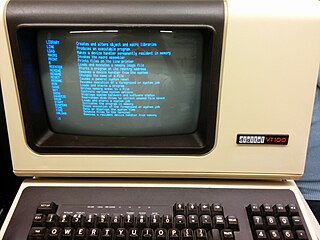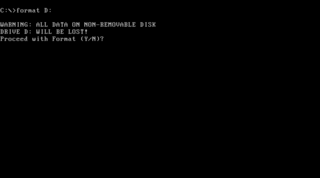
In computing, dir (directory) is a command in various computer operating systems used for computer file and directory listing. It is one of the basic commands to help navigate the file system. The command is usually implemented as an internal command in the command-line interpreter (shell). On some systems, a more graphical representation of the directory structure can be displayed using the tree command.

fdisk is a command-line utility for disk partitioning. It has been part of DOS, DR FlexOS, IBM OS/2, and early versions of Microsoft Windows, as well as certain ports of FreeBSD, NetBSD, OpenBSD, DragonFly BSD and macOS for compatibility reasons. Windows 2000 and its successors have replaced fdisk with a more advanced tool called diskpart.

In computing, XCOPY is a command used on IBM PC DOS, MS-DOS, IBM OS/2, Microsoft Windows, FreeDOS, ReactOS, and related operating systems for copying multiple files or entire directory trees from one directory to another and for copying files across a network.

In computing, exit is a command used in many operating system command-line shells and scripting languages.

In computing, CHKDSK is a system tool and command in DOS, Digital Research FlexOS, IBM/Toshiba 4690 OS, IBM OS/2, Microsoft Windows and related operating systems. It verifies the file system integrity of a volume and attempts to fix logical file system errors. It is similar to the fsck command in Unix and similar to Microsoft ScanDisk, which co-existed with CHKDSK in Windows 9x and MS-DOS 6.x.
In computing, share is a command for DOS that allows software to perform file locks. Locking files became necessary when MS-DOS began allowing files to be accessed simultaneously by multiple programs, either through multitasking or networking.

In computing, tree is a recursive directory listing command or program that produces a depth-indented listing of files. Originating in PC- and MS-DOS, it is found in Digital Research FlexOS, IBM/Toshiba 4690 OS, PTS-DOS, FreeDOS, IBM OS/2, Microsoft Windows, and ReactOS. A version for Unix and Unix-like systems is also available.

In computing, ATTRIB is a command in Intel ISIS-II, DOS, IBM OS/2, Microsoft Windows and ReactOS that allows the user to change various characteristics, or "attributes" of a computer file or directory. The command is also available in the EFI shell.
In computing, sys is a command used in many operating system command-line shells and also in Microsoft BASIC.

In computing, del is a command in command-line interpreters (shells) such as COMMAND.COM, cmd.exe, 4DOS, NDOS, 4OS2, 4NT and Windows PowerShell. It is used to delete one or more files or directories from a file system.

In computing, the print command provides single-user print spooling capability in a number of operating systems. It is roughly similar to that provided by the UNIX System V lp and BSD lpr print spooler systems.

In computing, find is a command in the command-line interpreters (shells) of a number of operating systems. It is used to search for a specific text string in a file or files. The command sends the specified lines to the standard output device.
In computing, label is a command included with some operating systems. It is used to create, change, or delete a volume label on a logical drive, such as a hard disk partition or a floppy disk. Used without parameters, label changes the current volume label or deletes the existing label.

In computing, help is a command in various command line shells such as COMMAND.COM, cmd.exe, Bash, qshell, 4DOS/4NT, Windows PowerShell, Singularity shell, Python, MATLAB and GNU Octave. It provides online information about available commands and the shell environment.

In computing, copy is a command in various operating systems. The command copies computer files from one directory to another.

In computing, format, a command-line utility that carries out disk formatting. It is a component of various operating systems, including 86-DOS, MS-DOS, IBM PC DOS and OS/2, Microsoft Windows and ReactOS.

In computing, choice is a command that allows for batch files to prompt the user to select one item from a set of single-character choices. It is available in a number of operating system command-line shells.
In computing, diskcopy is a command used on a number of operating systems for copying the complete contents of a diskette to another diskette.
In computing, recover is a primitive file system error recovery utility included in MS-DOS / IBM PC DOS versions prior to DOS 6.0 and a number of other operating systems.
The command-line tool exe2bin is a post-compilation utility program available on MS-DOS and other operating systems.













